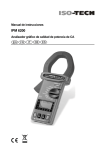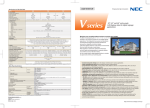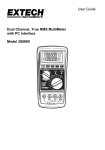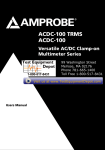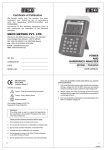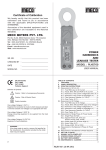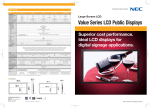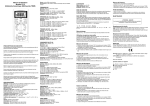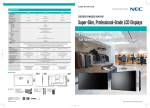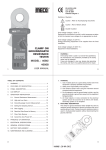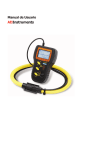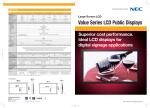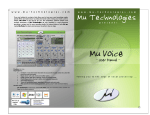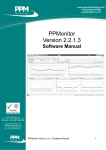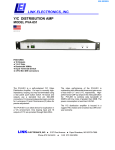Download PHT4545
Transcript
® ® Certificate of Calibration We hereby certify that this product has been calibrated and found to be in accordance with the applicable SPECIFICATIONS and STANDARDS. Accuracies of the standard equipment used in this calibration are traceable to the National Standards. MECO METERS PVT. LTD. Plot No. EL-60, MIDC Electronic Zone, TTC Industrial Area, Mahape, Navi Mumbai - 400710 (INDIA) Tel : 0091-22-27673311-16, 27673300 (Board) Fax : 0091-22-27673310, 27673330 E-mail : [email protected] Web : www.mecoinst.com SR. NO. AC CLAMP-ON POWER AND HARMONICS TESTER : CHECKED BY : DATE : MODEL : PHT4545 MODEL NO. : USER MANUAL EN 61010-2-032 CAT III 600V Pollution Degree 2 Definition of Symbols : Caution : Refer to Accompanying Documents Caution : Risk of Electric Shock Double Insulation Over-voltage Category I (CAT I) : Equipment for connection to circuits in which measurps are taken to limit the transient over-voltages to an appropriate low level. Over-voltage Category II (CAT II) : Energy-consuming equipment to be supplied from the fixed installation. Over-voltage Category III (CAT III) : Equipment in fixed installations. WARNING : If the clamp meter is used in a manner Not specified by the manufacturer, the protection Provided by the clamp meter may be impaired. 2 TABLE OF CONTENTS I. FEATURES ........................................................................ 2 II. PANEL DESCRIPTION ..................................................... 3 III. OPERATING INSTRUCTIONS ......................................... 6 lll.1. Measurenment of ACA ............................................ 6 lll.1.1. True RMS value of AC Current ................................ 7 lll.1.2. HOLD, MAX, MIN and.PEAKofAC Current ............. 7 lll.1.3. Harmonics of AC Current in Magnitude (V) ............ 8 lll.1.4. Harmonics ofAC Current in Percentage (%) ........... 8 lll.1.5. Total Harmonic Distortion (% THD-F) ...................... 9 lll.1.6. Crest Factor(C.F.) .................................................. 10 lll.2. Measurement of AC Voltage ............................................ 11 lll.2.1. True RMS value of AC Voltage ............................. 11 lll.2.3. HOLD, MAX, MIN and PEAK value of AC Voltage 12 lll.2.3. Harmonics of AC Voltage in Magnitude (V) ........... 13 lll.2.4. Harmonics of AC Voltage in Percentage (%) ........ 14 lll.2.5. Total Harmonics Distortion (% THD-F) .................. 14 lll.2.6. Crest Factor (C.F.) ................................................. 15 lll.3. Measurement of Single Phase AC Power Quality ........... 16 lll.3.1. Single Phase AC Watt and Power Factor (PF) ..... 17 lll.3.2. Apparent Power (VA, KVA) and Reactive Power (VAR, KVAR) ............................... 17 lll.3.3. Phase Angle (u) ..................................................... 18 lll.3.4. Horse Power (H.P) ................................................ 18 lll.3.5. Energy (WH, or KWH) ........................................... 19 lll.4 Measurement ot the Balanced 3 Phase AC Power Quality .................................................................... 20 lll.5 Measurement of the Balanced 3 Phase Sequence lll.6 Measurement of Resistance and Continuity with Beeper ................................................................... 23 IV. SET THE CT RATIO ........................................................ 24 V. DISABLE AUTO-POWER-OFF ....................................... 24 Vl. SPECIFICATIONS (230C±50C) ........................................ 25 Vll. BATTERY REPLACEMENT ........................................... 30 Vlll. MAINTENANCE & CLEANING ....................................... 31 3 4545 : 28-09-2012 1. FEATURES 2. PANEL DESCRIPTION a. Active (W, KW, HP), reactive (VAR, KVAR) and apparent (VA, KVA) power. b. Power factor (PF), phase angle (u), and energy (WH, KWH). c. Non-interrupted AC current harmonic analysis. d. 1 to 99th order of harmonics at 2.0% basic accuracy. e. Total harmonic distortion (%THD-F) and crest factor (CF). f. True RMS measurement of V and A at 0.5% basic accuracy. g. Fast peak function (39ms for 50 Hz, 33ms for 60Hz). h. Resistance and Continuity with Beeper Measurement of balanced 3f power. j. Measurement of balanced 3f sequence. k. Programmable CT ratio from 1 to 250. l. Max, Min and data hold functions. m. Active power in H.P. n. Auto power off function in 30 minutes. 4 1. Transformer Jaw Assembly This is used to pick up current signal. To measure AC current or Power/Watt, the jaw must enclose conductor completely. 2. Transformer Trigger Press the trigger to open the jaw. 3. Rotary Switch This is used to turn the power on and select measurement of current, voltage or power. 4. MAX/MIN/HOLD/PEAK In the measurement of A, or V, press this button to perform function of MAXIMUM, MINIMUM, HOLD or PEAK. If this button is hold when turning on power, the tester can perform measurement of phase sequence instead of phase angle in the balanced 3f power system. 5. s 3f Button This button is used to increment order of harmonics or CT ratio. When the rotary switch is set at W position, press this button to select measurement of balanced 3f power instead of single-phase power. 6. FUNC Button In the measurement of A, or V, press this button to select function of harmonics, THD-F, or CF. In the measurement of W with PF, press this button to select function of VA, VAR, phase angle, HP, or energy (KWH). 7. LCD This is a 4+4 digit Liquid Crystal Display. Function symbols, units, sign, decimal points, low battery symbols, max, min symbols, peak and harmonic symbols are included. 8. Symbols Those are symbols of selected functions such as, Hamonic, PEAK, MAX, MIN or HOLD. 9. Primary Digits The primary digits display the main function such as voltage, current, wattage, and apparent power. 5 10. Secondary Digits These digits display secondary function of measurement, such as power factor, reactive power, and the order of harmonics. 11. Symbols of Units These are unit symbols for Current, voltage, and power. The nominal frequency (50 or 60 Hz) of measurement is displayed above these unit symbols. 12. V Input Terminal This terminal is used as input for voltage and power measurements. 13. COM Terminal This terminal is used as common reference input. 14. Frequency Select Function Press this button to select nominal frequency (50 or 60Hz) 15. t button It is used to decrement the order of hamonics or CT ratio. Holding this button when turning on the power will fix the measuring frequency at 50 or 60 Hz Symbol of Current Transformer (CT) 16. If the CT ratio is not 1, this symbol will be displayed in LCD. 6 7 4545 : 28-09-2012 3. OPERATING INSTRUCTIONS 3. 1.1. True RMS value of AC Current 3.1 Measurement of ACA NOTE: 1. Set the rotary switch at the A position. 2. The unit will measure and display signal frequency. If users wish to fixed the frquency 50 or 60, users can hold the t button when turning on the power. 3. If the peak value of the input AC current is greater than the maximum value of the range, then symbol of OL will be displayed. NOTE : Whenever the rotary switch is set at new position, the CT ratio will be displayed first. If the CT ratio is not 1, a symbol " " will be shown in the LCD display for the measurment of A. The reading of current shown in LCD is equal to the true RMS value measured by the tester multiplied by CT ratio (A LCD = ARMS x CT). WARNING : Make sure that all the test leads are disconnected from the meter's terminals for current measurement. a. Set the rotary switch at A Then select the correct frequency by pressing the 50/60 Hz button. b. Press the trigger to open the jaw and fully enclose the conductor to be measured. c. Read the measured value from the LCD display. 3. 1.2. HOLD, MAX, MIN and PEAK of AC Current. a. Set the rotary switch at A. Then select the correct frequency by pressing the 50/60 Hz button. b. Press the trigger to open the jaw and fully endose the conductor to be measured. c. The measured value from the LCD display. If the HQLD button is pressed, the symbol of “HOLD”, “MAX”, “MIN” or “PEAK” will be shown in LCD alternatively. And the value of the HOLD, MAX, MIN or PEAK function will be displayed in LCD alternatively. d. To return to the display of current measurement, hold the HOLD button for more than 2 seconds. NOTE : The PEAK function displays the maximum value of the input waveform. The sampling time for the PEAK function is 39ms (50Hz) or 33ms (60Hz). The HOLD, MAX, or MIN function displays the true RMS value. 8 9 3. 1.3. Harmonics of AC Current in Magnitude a. Set the rotary switch at A. Then select the conect frequency by pressing the 50/60 Hz button. b. Press the trigger to open the jaw and fully enclose the conductor to be measured. c. Press the FUNC button once. The symbols of “Harmonic” and “NO.” will be shown in LCD. The n-th order (1 to 99) will be shown in the upper row digits. d. Press the s or t button to increment or decrement the order of harmonics in the upper row digits. The number will roll over when the maximum (99) or minimum (1) is reached. 3. 1.4. Harmonics of AC Current in Percentage (%) d. Press the s or t button to increment or decrement the order of harmonics in the upper row digits. The number will roll over when the maximum (99) or minimum (1) is reached. 3. 1.5. Total Harmonic Distortion (% THD-F) a. Set the rotary switch at A. Then select the correct frequency by pressing the 50/60 Hz button. b. Press the trigger to open the jaw and fully enclose the conductor to be measured. c. Press the FUNC button three times. The symbols of “THD” and “%” will be shown in LCD. The total harmonic distortion in percentage with respect to the fundamental frequency (50 or 60 Hz) will be measured and displayed. %THD-F = ( (V22+ V32 + ... V492+ V502) / V1) * 100 Where, V1: magnitude at the 50 or 60 Hz V2: magnitude at the second harmonics ... V50: magnitude at the 99-th harmonics. a. Set the rotary switch at “A” position. Then select the correct frequency by pressing the 50/60 Hz button, b. Press the trigger to open the jaw and fully enclose the conductor to be measured. c. Press the FUNC button twice. The symbols of “Harmonic” and “NO.” will be shown in LCD. The n-th order (1 to 99) will be shown in the upper row digits. 10 11 4545 : 28-09-2012 3. 1.6. Crest Factor (C.F.) a. Set the rotary switch at A. Then select the correct frequency by pressing the 50/60 Hz button. b. Press the trigger to open the jaw and fully enclose the conductor to be measured. c. Press the FUNC button four times. The symbols of C.F. will be shown in LCD. The crest factor (C.F.) will be measured and displayed. The crest factor (CF) is defined as following: C.F. = (peak value) / (RMS value) 3.2 Measurement of AC Voltage NOTE : 1. The unit will measure and display signal frequency. If users wish to fixed the frquency at 50 or 60, users can hold the t button when turning on the power. 2. If the peak value of the input AC voltage is greater than the maximum value of the range, then symbol of OL will be displayed. NOTE : Whenever the rotary switch is set at a new position, the CT ratio will be displayed first. If the CT ratio is not 1, a symbol of “ ” will be shown in the LCD display. WARNING : Maximum input for ACV is 600. Do not attempt to take any voltage measurement that exceeds the limits. Exceeding the limits could cause electrical shock and damage to the clamp meter. 12 3. 2.1. True RMS value of AC Voltage a. Set the rotary switch at position V. Then select the correct fundamental frequency by pressing the 50/60 Hz button. b. Insert the test leads into the input jack. Connect the test prods of the test leads in PARALLEL to the circuit to be measured. c. Read the measured RMS value from the LCD display. 3. 2.2. HOLD, MAX, MIN and PEAK value of AC Voltage a. Set the rotary switch at position V. Then select the correct fundamental frequency by pressing the 50/60 Hz button. b. Insert the test leads into the input jack. Connect the test prods of the test leads in PARALLEL to the circuit to be measured. c. The measured value is displayed in the LCD display. If the HOLD button is pressed, the symbol of “HOLD”, “MAX”, “MIN” or “PEAK” will be shown in LCD alternatively. And the value of the HOLD, MAX, MIN or PEAK function will be displayed in LCD alternatively. d. To return to the display of current measurement, hold the HOLD button for more than 2 seconds. 14 13 NOTE : The PEAK function displays the maximum value of the input wavefom.The sampling time for the PEAK function is 39ms (50Hz) or 33ms (60Hz). The HOLD, MAX, or MIN function displays the true RMS value. 3. 2.3. Harmonics of AC Voltage in Magnitude (V) a. Set the rotary switch at position V. Then select the correct fundamental frequency by pressing the 50/60 Hz button. b. Insert the test leads into the input jack. Connect the test prods of the test leads in PARALLEL to the circuit to be measured. c. Press the FUNC button once. The symbols of “Harmonic” and “NO” will be shown in LCD. The n-th order (1 to 99) will be shown in the upper row digits. d. Press the s or t button to increment or decrement the order of harmonics in the upper row digits. The number will roll over when the maximum (99) or minimum (1) is reached. 15 4545 : 28-09-2012 3. 2.4. Harmonics of AC Vollage in Percentage (%) a. Set the rotary switch at position V. Then select the correct fundamental frequency by pressing the 50/60 Hz button. b. Insert the test leads into the input jack. Connect the test prods of the test leads in PARALLEL to the circuit to be measured. c. Press the FUNC button twice. The symbols of "Hamonic" and "NO" will be shown in LCD. The n-th order (1 to 99) will be shown in the upper row digits. d. Press the s or t button to increment or decrement the order of harmonics in the upper row digits. The number will roll over when the maximum (99) or minimun (1) is reached. 3. 2.5. Total Harmonic Distortion (% THD-F) c. Press the FUNC button three times. The symbols of “THD” and “%” will be shown in LCD. The total harmonic distortion in percentage with respect to the fundamental frequency (50 or 60 Hz) will be measured and displayed. %THD-F=( (V22+V32 + ... +V492+V502)/V1) * 100 Where, V1: magnitude at the 50 or 60 Hz V2: magnitude at the second harmonics ... V50: magnitude at the 50-th harmonics. 3. 2.6. Crest Factor (C.F.) a. Set the rotary switch at posilion V. Then select the correct fundamental frequency by pressing the 50/60 Hz button. b. Insert the test leads into the input jack. Connect the test prods of the test leads in PARALLEL to the circuit to be measured. c. Press the FUNC button four times. The symbols of C.F. will be shown in LCD. The crest factor (C.F.) will be measured and displayed. The crest factor (CF) is defined as following: C.F. (Crest Factor) = (Peak Value) / (RMS Value) a. Set the rotary switch at position V. Then select the correct fundamental frequency by pressing the 50/60 Hz button. b. Insert the test leads into the input jack. Connect the test prod’s of the test leads in PARALLEL to the circuit to be measured. 16 3. 3 Measurement of Single Phase AC Power Quality NOTE : 1. Set the rotary switch at the W position. 2. Select the correct fundamental frequency of current and voltage by pressing the 50/60 Hz button 3. If the peak value of the input AC current or AC voltage is greater than the maximum value of the range, then symbol of OL will be displayed. NOTE : Whenever the rotary switch is set at a new position, the CT ratio will be displayed first. If the CT ratio is not 1, a symbol of “ ” will be shown in the LCD display for the measurement of W. The reading of current shown in LCD is equal to the W, VA, and VAR values measured by the tester multiplied by CT ratio (WLCD= W x CT, VALCD= VA x CT, VARLCD= VAR x CT, WHLCD = WH x CT). 18 17 3. 3.1 Single Phase AC Watt and Power Factor (PF) a. Connect the test leads to the voltage source in parallel with the load. b. Clamp on one of the wire to the load. The current should flow frcm the front of the tester to the side of the battery cover. c. Set the rotary switch at the W position. d. Read the values of W or KW and PF shown on LCD. The unit of watt is automatically scaled. 3. 3.2. Apparent Power (VA, KVA) and Reactive Power (VAR, KVAR) a. Connect the test leads to the voltage source in parallel wilh the load. b. Clamp on one of the wire to the load. The current should flow from the front of the tester to the side of the battery cover. c. Set the rotary switch at the W position. d. The value of W, or KW and PF will be displayed in LCD. e. Press the FUNC button once to display VA or KVA and VAR or KVAR. The unit is automatically scaled. 19 4545 : 28-09-2012 3. 3.3. Phase Angle (u) a. Connect the test leads to the voltage source in parallel with the load. b. Clamp on one of the wire to the laad. The current should flow from the front of the tester to the side of the battery cover. c. Set the rotary switch at the W position. e. The value of W, or KW will be displayed in LCD. The unit of watt is automatically scaled. f. Press the FUNC button three times to display phase angle (u) from 1800 to +1800. NOTE : To display phase angle (u) from 0 to 360, hold the s button, then turn the power on. Once the tester is turned on in this way, the tester will display phase angle from 0 to 3600 (when phase angle function is selected). 3. 3.4. Horse Power (H.P.) b. Clamp on one of the wire to the load. The current should flow from the front of the tester to the side of the battery cover. c. Set the rotary switch at the W position. d. The vaiue of W, or KW and PF will be displayed in LCD. The unit of watt is automatically scaled. e. Press the FUNC button four times to display power in the unit of HP. 3. 3.5. Energy (WH, or KWH) a. Connect the test leads to the voltage source in parallel with the load. b. Clamp on one of the wire to the load. The current should flow from the front of the tester to the side of the battery cover. c. Set the rotary switch at the W position. d. The values of W, or KW and PF will be displayed in LCD. The unit of watt is automatically scaled. e. Press the FUNC button five times. A character of H is displayed in front of reading to indicate energy (WH or KWH). a. Connect the test leads to the voltage source in parallel with the load. 20 21 3.4 Measurement of the Balanced 3 Phase AC Power Quality a. Connect the black test lead to the voltage L3, and connect the red test lead to L1. b. Clamp on one of the wire to L2. The cun ent should flow from the front of the tester to the side of the battery cover. c. Set the rotary switch at the W position. d. Press the s 3f button to select balanced 3f. Symbols of ‘‘3f3W, 3f4W and BAL” will be shown in LCD. e. The value of W or KW and PF will be displayed in LCD. The unit of watt is automatically scaled. f. If the FUNC button is pressed again, the apparent power (VA) and reactive power (VAR) will be shown in LCD. g. To measure the phase angle and phase sequence, users can press the FUNC button again. h. If the FUNC button is pressed again, the true power in the unit of Horse Power (HP) will be shown in LCD. i. To measure the energy (WH), users can press the FUNC button again. The current energy (WH or KWH) will be shown in LCD. NOTE : Users can also obtain the measurements of VA, VAR, Phase Angle, phase sequence, HP, and energy (WH) for balanced 3f power system. The operations are the same as the measurements for the single-phase power system. 22 NOTE : The reading of current shown in LCD is equal to the W, VA, and VAR value measured by the tester multiplied by CT ratio (WLCD= W x CT, VALCD= VA x CT, VARLCD= VAR x CT, WHLCD= WH x CT) 23 4545 : 28-09-2012 3.5 Measurement of the Balanced 3 Phase Sequence a. Set the rotary switch at the W position b. Connect the black test lead to the voltage L3, and connect the red test lead to L1. c. Clamp on to the wire of L2. The current should flow from the front of the tester to the side of the battery cover. d. Press the s 3f button to select 3 phase power system. A symbol of 3f will be shown in LCD. e. Press the FUNC button to select phase angle function. The LCD will show L123 to indicate the clockwise sequence in the upper row digits of LCD. Or the LCD will show L132 to indicate counter clockwise sequence. 3.6 Measurement of Resistance and Continuity with Beeper 24 25 a. Set the rotary switch at V b. Insert the test leads into the input jack. c. Connect the test prods of the test leads to the two ends of the resistor or circuit to be measured. d. Read the measured value from the LCD display. e. If the resistance is lower than 50 V, a beeping sound shall be heard. 4. SET THE CT RATlO To set the CT ratio, hold the FUNC button, and then turn the power on. A symbol of ‘‘ ’’ will be shown in LCD. The default value of CT is 1. To change the CT ratio, users can press the s or t button to increment or decrement the value by 1, Holding the s or t button will speed up the process of incrementing or decrementing. To exit the setting of CT ratio, press the FUNC button. 6. SPECIFICATIONS(230C±50C) AC Watt (50 or 60 Hz, PF 0.5 to 1. CT = 1, Voltage > AC 5V, Current > AC 5A, and continuous waveform) Range Resolution Accuracy of Readings1 >20V & >20A <20V or <20A 10.0 - 999.9 W 0.1W ±2% ± 20dgts ±2% ± 40dgts 1.000 - 9.999 KW 0.001 KW ±2% ± 20dgts ±2% ± 40dgts 10.00 99.99 KW 0.01 KW ±2% ± 20dgts ±2% ± 40dgts 100.0 - 999.9 KW 0.1 KW ±2% ± 20dgts ±2% ± 40dgts 1000 - 9999 KW 1 KW ±2% ± 20dgts ±2% ± 40dgts 1 For CTf1, the accuracy in percentage is the same (±2%). But the additional wattage should be multiplied by the CT ratio. For example, ±2.0W becomes ±2.0W * CT ratio ±4.0W becomes ±4.0W * CT ratio 5. DISABLE AUTO-POWER-OFF The tester has an auto-power-off function. The tester will turn the power off after power is turned on for 30 minutes. To disable the auto power off function, hold the FUNC button for more than 2 seconds. A beep sound will be heard to indicate that the auto power off function is disabled. 26 27 4545 : 28-09-2012 AC Apparent Power (VA, from 0.000VA to 9999 KVA) Range Resolution Accuracy of Readings2 >20V & >20A <20V or <20A 10.0 - 999.9 VA 0.1VA ±2% ± 20dgts ±2% ± 40dgts 1.000 - 9.999 KVA 0.001 KVA ±2% ± 20dgts ±2% ± 40dgts 10.00 - 99.99 KVA 0.01 KVA ±2% ± 20dgts ±2% ± 40dgts 100.0 - 999.9 KVA 0.1 KVA ±2% ± 20dgts ±2% ± 40dgts 1000 - 9999 KVA 1 KVA ±2% ± 20dgts ±2% ± 40dgts 2 For CTf1, the accuracy in percentage is the same (±2%). But the additional VA should be multiplied by the CT ratio. For example, ±2.0VA becomes ±2.0VA * CT ratio ±4.0VA becomes ±4.0VA * CT ratio AC Reactive Power (VAR, from 0.000 VAR to 9999 KVAR) Resolution Accuracy of Readings3 Range >20V & >20A <20V or <20A 10.0 - 999.9 VAR 0.1VAR ±2% ± 30dgts ±3% ± 40dgts 1.000 - 9.999 KVAR 0.001 KVAR ±2% ± 30dgts ±3% ± 40dgts 10.00 - 99.99 KVAR 0.01 KVAR ±2% ± 30dgts ±3% ± 40dgts 100.0 - 999.9 KVAR 0.1 KVAR ±2% ± 30dgts ±3% ± 40dgts 1000 - 9999 KVAR 1 KVAR ±2% ± 30dgts ±3% ± 40dgts 3 For CTf1, the accuracy in percentage is the same (±2%). But the additional VAR should be multiplied by the CT ratio. For example, ±3.0VAR becomes ±3.0VAR * CT ratio ±4.0VAR becomes ±4.0VAR * CT ratio Range of CT (Current Transformer) Ratio : 1 to 250 H.P. (Horse Power) 1 H.P. = 746 W AC Active Energy ( WH, or KWH, from 0 WH to 999,999 KWH) WH = W * Time (in hours) AC Current (50 or 60 Hz, Auto Range, True RMS, Crest Factor < 4, CT=1) (Overload Protection AC 2000A) Range Resolution Accuracy of Readings4 10.0 - 1500.0 A 0.01 A ± 2% ± 5dgts 4 For CT = 1, the accuracy in percentage is the same (±2%). But the additional digits should be multiplied by the CT ratio. For example, ±5 digits becomes ±5 digits * CT ratio AC Voltage (50 or 60 Hz, Auto Range, True RMS, Crest Factor < 4, Input Impedance 10 MV, Overload Protection AC 800V) Range Resolution Accuracy of Readings 10.0 V - 600.0 V 0.1 V ± 0.5% ± 5dgts Harmonics of AC Voltage in Percentage (1 to 99 order, minimum voltage at the 50 or 60 Hz > AC 80V. If the voltage is 0 at 50 or 60 Hz, all the percentage (%) display is 0.) Range Resolution Accuracy 1 - 20th 0.1% ±2% 21 - 49th 0.1% 4%of reading ± 2.0% 50 - 99th 0.1% 6%of reading ± 2.0% Harmonics of AC Voltage in Magnitude (1 to 99th order, minimum voltage at the 50 or 60 Hz > AC 80V) Range Resolution Accuracy 1 - 20th 0.1% ± 2.0% ± 0.5V 21 - 49th 0.1% 4%of reading ± 0.5V 50 - 99th 0.1% 6%of reading ± 0.5V Harmonics of AC Current in Percentage (1 to 99th order, minimum current at the 50 or 60 Hz o 20 A. If the current is 0 at 50 or 60 Hz, all the percentage (%) display is 0.) Range Resolution Accuracy 0.1% ±2% 1 - 20th 21 - 49th 0.1% 4% of reading ± 2.0% 50 - 99th 0.1% 6% of reading ± 2.0% Harmonics of AC Current in Magnitude (1 to 99th order, minimum current at the 50 or 60 Hz > 20A) Range Resolution Accuracy 1 - 20th 0.1% ± 2% of reading ± 0.4A 21 - 49th 0.1% ± 4% of reading ± 0.4A 0.1% ± 6% of reading ± 0.4A 50 - 99th Power Factor (PF) Range Resolution Accuracy >20V & >20A <20V or <20A 0.000 - 1.000 0.001 ± 0.04 ± 0.1 Phase Angle (u) Range Resolution Accuracy -180 to 1800 0.10 ±10 0 to 3600 0.10 ±10 Total Harmonic Distortion (THD-F with respect to the 50 or 60 Hz, min. value at the 50 or 60 Hz > 80V and > 20 A, 1 to 50 Harmonics. If the voltage or current is 0 at 50 or 60 Hz, all the percentage (%) dispiay is 0) Range Resolution Accuracy 0.0 - 20% 0.1% ±2.0% 20 - 100% 0.1% ± 6% of reading ±1% 100 - 999.9% 0.1% ±10% of reading ±1% Peak Value of AC Voltage (peak value > 5V) or AC Current (peak value > 20A) Range Sampling Time Accuracy of Reading 50 Hz 39 ms ± 5% ± 30 digits 60 Hz 33 ms ± 5% ± 30 digits Crest Factor (C.F.) of ACV (peak value > 5V) or ACA (peak value > 20A) Range Resolution Accuracy of Reading 1.00 - 99.99 0.01 ± 5% ± 30 digits Resistance (V) and Continuity (Beep if less than 50V) Range Resolution Accuracy 7.0 - 999.9 V 0.1 V ±5V 1000 - 1200 V 1V ±5V If reading is less than 7V, it is displayed as 0V Frequency (RMS Value >10V) or ACA (RMS value >30A) Range Resolution Accuracy of Readings 45 - 65 0.1 ± 0.2 Hz 28 29 30 31 4545 : 28-09-2012 Indoors Use Conductor Size : 55mm (approx.), 64 x 24mm (bus bar) Battery Type : two 1.5V SUM-3 Display : 4+4 digits LCD Range Selection : Auto Overload lndication : OL Power Consumption : 10mA (approx.) Low battery Indication : Auto-Power-Off : 30 minutes after power-on Update Time : 2 times/sec. (display) 7. BATTERY REPLACEMENT When the low battery symbol is displayed on the LCD, replace the old batteries with two new batteries. No. Of Samples per Period : 512 (voltage or current) 256 (power) Operating Temperature : -100C to 500C Operating Humidity : less than 85% relative Altitude : up to 2000M Storage Temperature : -200C to 600C Storage Humidity : less than 75% relative Dimension : 210 x 62 x 35.6mm (approx.) Weight : 640gms including battery (approx.) Accessories : Test leads x 1 Carrying bag x 1 Instruction manual x 1 Batteries 1.5V x 2 (installed) Option : Alligator clips A. Turn the power off and remove the test leads from the clamp meter. B. Remove the screw of the back cover. C. Lift and remove the back cover. D. Remove the old batteries. E. Insert two new 1.5V SUM-3 batteries. F. Place the back cover and secure the screw. 32 8. MAINTENANCE & CLEANING Servicing not covered in this manual should only be performed by qualified personnel. Repairs should only be performed by qualified personnel. Periodically wipe the case with a damp doth and detergent; do not use abrasives or solvents. 34 33 NOTE ○ ○ ○ ○ ○ ○ ○ ○ ○ ○ ○ ○ ○ ○ ○ ○ ○ ○ ○ ○ ○ ○ ○ ○ ○ ○ ○ ○ ○ ○ ○ ○ ○ ○ ○ ○ ○ ○ ○ ○ ○ ○ ○ ○ ○ ○ ○ ○ ○ ○ ○ ○ ○ ○ ○ ○ ○ ○ ○ ○ ○ ○ ○ ○ ○ ○ ○ ○ ○ ○ ○ ○ ○ ○ ○ ○ ○ ○ ○ ○ ○ ○ ○ ○ ○ ○ ○ ○ ○ ○ ○ ○ ○ ○ ○ ○ ○ ○ ○ ○ ○ ○ ○ ○ ○ ○ ○ ○ ○ ○ ○ ○ ○ ○ ○ ○ ○ ○ ○ ○ ○ ○ ○ ○ ○ ○ ○ ○ ○ ○ ○ ○ ○ ○ ○ ○ ○ ○ ○ ○ ○ ○ ○ ○ ○ ○ ○ ○ ○ ○ ○ ○ ○ ○ ○ ○ ○ ○ ○ ○ ○ ○ ○ ○ ○ ○ ○ ○ ○ ○ ○ ○ ○ ○ ○ ○ ○ ○ ○ ○ ○ ○ ○ ○ ○ ○ ○ ○ ○ ○ ○ ○ ○ ○ ○ ○ ○ ○ ○ ○ ○ ○ ○ ○ ○ ○ ○ ○ ○ ○ ○ ○ ○ ○ ○ ○ ○ ○ ○ ○ ○ ○ ○ ○ ○ ○ ○ ○ ○ ○ ○ ○ ○ ○ ○ ○ ○ ○ ○ ○ ○ ○ ○ ○ ○ ○ ○ ○ ○ ○ ○ ○ ○ ○ ○ ○ ○ ○ ○ ○ ○ ○ ○ ○ ○ ○ ○ ○ ○ ○ ○ ○ ○ ○ ○ ○ ○ ○ ○ ○ ○ ○ ○ ○ ○ ○ ○ ○ ○ ○ ○ ○ ○ ○ ○ ○ ○ ○ ○ ○ ○ ○ ○ ○ ○ ○ ○ ○ ○ ○ ○ ○ ○ ○ ○ ○ ○ ○ ○ ○ ○ ○ ○ ○ ○ ○ ○ ○ ○ ○ ○ ○ ○ ○ ○ ○ ○ ○ ○ ○ ○ ○ ○ ○ ○ ○ ○ ○ ○ ○ ○ ○ ○ ○ ○ ○ ○ ○ ○ ○ ○ ○ ○ ○ ○ ○ ○ ○ ○ ○ ○ ○ ○ ○ ○ ○ ○ ○ ○ ○ ○ ○ ○ ○ ○ ○ ○ ○ ○ ○ ○ ○ ○ ○ ○ ○ ○ ○ ○ ○ ○ ○ ○ ○ ○ ○ ○ ○ ○ ○ ○ ○ ○ ○ ○ ○ ○ ○ ○ ○ ○ ○ ○ ○ ○ ○ ○ ○ ○ ○ ○ ○ ○ ○ ○ ○ ○ ○ ○ ○ ○ ○ ○ ○ ○ ○ ○ ○ ○ ○ ○ ○ ○ ○ ○ ○ ○ ○ ○ ○ ○ ○ ○ ○ ○ ○ ○ ○ ○ ○ ○ ○ ○ ○ ○ ○ ○ ○ ○ ○ ○ ○ ○ ○ ○ ○ ○ ○ ○ ○ ○ ○ ○ 4545 : 28-09-2012









